No.2 Telegraph Insulator
By Glenn Drummond
Reprinted from "Crown Jewels of the Wire", January 2005, page 30
The No.2 Telegraph Insulator was introduced to the trade by the Hemingray
Glass Company in the early 1870's. Unfortunately, the trade name for these
insulators has been lost because no catalogs or sales sheets survive from that
era. Therefore, for the purposes of this article, the insulators are referred to
as the "No.2 Telegraph Insulator".
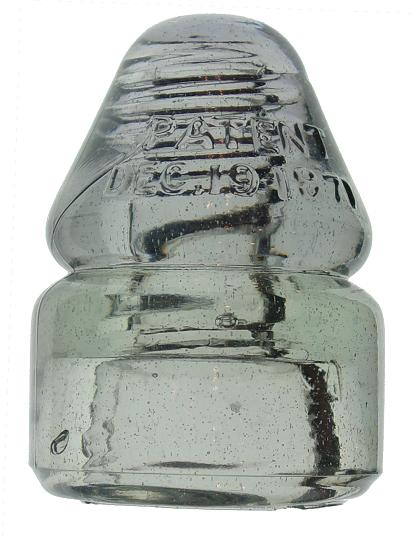
A characteristic three-piece mold assembly was used by the Hemingray Glass
Company to manufacture their early insulators. The top of the crown, often
referred to as the dome, was formed in a shallow cavity tooled into the base of
the mold assembly. A raised line around the perimeter of the crown, known as the
mold line, clearly reveals where the two side pieces of the mold assembly fit
against the base. The three piece mold configuration enables collectors and
historians to determine that a small number of unembossed, threaded glass
insulators... including an unembossed variant of the No.2 Telegraph Insulator,
were manufactured by the Hemingray Glass Company prior to receipt of the
"1871" patent. With one exception, all embossed variants of the No.2
Telegraph Insulators show the "PATENT/ DEC. 19. 1871" embossing on the
crown. (The one exception is a one-line embossing discussed later in the
article.) The embossed patent date is a positive indicator that the insulators
were manufactured by Hemingray.
A U.S. Patent Office document reveals that Robert Hemingray began
experimenting with the manufacture of threaded glass insulators as early as the
summer of 1868. Hemingray's testimony indicates that at least two design styles
of telegraph insulators preceded his patent application and its subsequent
approval. A cursory study of early unembossed telegraph insulators manufactured
by Hemingray found a continuing trial-and-error evolution of the press assembly
used to create the threaded pin cavity. Observations made during the referenced
study revealed one very curious feature about the insulators examined. Those
believed to have been among the first to be manufactured were very well made,
followed by a noticeable degradation of quality characteristics, after which the
quality was observed to slowly improve over time. The more obvious problems
associated with the degraded insulators were: poorly formed threads, open
bubbles in the pin cavity, and skewed pin cavity alignment. The study did not
include a detailed examination of the early unembossed and embossed No.2
Telegraph insulators specimens. Nevertheless, the same general trends have been
observed while examining a moderate number of No.2 Telegraph Insulators during
preparation of this article. The No.2 Telegraph Insulator can be separated into
six groups, or generations.
First Generation
It is considered obvious that the initial production of the No.2 Telegraph
Insulators occurred prior to 1872 by the absence of the "PATENT / DEC. 19.
1871" crown embossing. The number of unembossed No. 2's known to exist
within the hobby at this time is small. A very few were found along an abandoned
telegraph line adjacent to the old Mad River and Lake Erie Railroad roadbed
located in northwestern Ohio during the late 1960's. An equally small number
have recently been found in excavations along that same line. It is speculated
that the No.2 styles were replacements for the original threadless insulators
installed on that line.

Unembossed
The first generation of No. 2's is characterized by a concave crown. The
concave crown was a generally accepted design used for a number of early
threadless insulators. These insulators are well made, appear to have been fire
polished, and contain few defects. Colors are typically dark aqua, dark green
aqua, and dark olive green.
Second Generation
The second generation is marked on the front crown with "PATENT / DEC.
19. 1871", but does NOT carry the design style number "2"
embossed on the reverse side of the crown. Although there is no conclusive
evidence that the molds used to manufacture the first generation were retooled
to produce the second generation, the dimensions of the insulator are identical.
The number of second generation insulators within known collections is also very
small. In all probability, these were also used as threadless replacements.
Production of this variant may have been limited to the latter half of 1872, or
the first half of 1873. It is difficult to compare the numbers of first and
second generation insulators; however, it seems the second generation varieties
were more widely distributed.
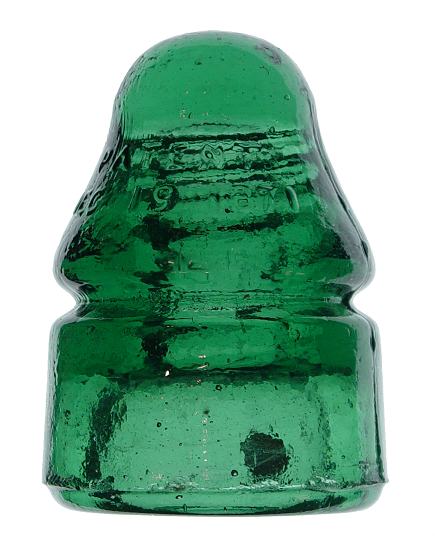
The second generation is also characterized by a concave crown, the only
difference being the addition of the patent date embossing on the front. Typical
colors are dark green aqua, green aqua, and olive green. A few
"celery" green and light green specimens have been recorded. It is
interesting to note that a number of purple specimens have been found in western
Pennsylvania.
Third Generation
The addition of the number "2" embossed on the
rear side of the crown is the only distinguishing feature of the third
generation when compared to the first and second generations. Undoubtedly, the
same molds were retooled to add the number "2". Likewise, it can be
seen that the same pressing equipment continued to be used to produce the third
generation. This observation is worth noting because it has been seen in
examining the other early Hemingray design styles that there was ongoing press
modifications during this time. It is probable that the molds were retooled to
add the style number during the summer shut-down in 1873. While the third
generation cannot be considered a "common" insulator, the number that
have survived suggests a gradual acceptance by telegraph companies and telegraph
equipment supply houses.
Fourth Generation
Demand for the No.2 Telegraph Insulator continued to grow and the fabrication
of additional insulator presses and most assemblies was required to satisfy
demand. In addition to improved presses, a significant design change is noted in
the fourth generation. A truncated, straight-sided cone shape replaced the
traditional concave crown. The cones was truncated by the base of the mold
assembly which was tooled to an oval configuration which enabled the two
surfaces to be tangent at the mold seam. The patent date and style number
embossing on the new mold sets took a variety of form, size, and placement.
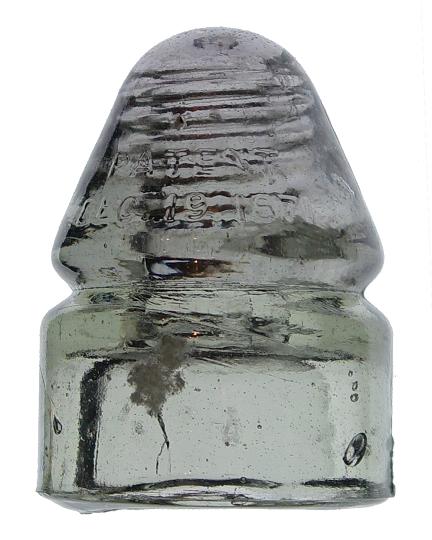
Changes in the mold assemblies resulted in an excessive amount of
"press-over" on some units. Another significant change in the fourth
generation insulators is that they are larger than the preceding generations. It
is likely that telegraph companies were demanding a heavier insulator that would
withstand the rigors of long-line service. On the other hand, a market remained
for the lighter weight insulators similar in size to the first three
generations. It was probably at this time, circa 1875, that the No.2 Telegraph
Insulators was "beefed" up and the No.3 Telegraph Insulator was added
to the inventory with approximately the same size characteristics as the first
through third generations of the No.2.
Fifth Generation
New molds were added to the inventory, some of which included certain letters
of the alphabet placed on the rear skirt. For a lack of a better term, these
letters are called "mold marks" herein. This topic is discussed
further below.
Sixth Generation
The final improvement to the No.2 Telegraph Insulator was made from improved
press and mold assemblies that were significantly different in their
construction. The outstanding feature of the new equipment was the elimination
of the floating head-plate used with the preceding five generations. The
head-plate was now integral with the hinged side pieces of the mold assembly
which resulted in the side mold seams running across the base of the insulator.
This feature also eliminated most of the "press-over" that was a waste
of glass.
Ornate Embossing.
Three examples of embossed letters and numbers may be observed that are out
of the ordinary for insulators manufactured during the "1871"
production era. Two of these are a rather ornate number "2." The third
is the mold mark letter "K." Ornate numbers similar to the
"2" shown here are common on the bottoms of various bottles and fruit
jars manufactured by the Hemingray Glass Company during this same period. The
ornate "K" mold mark, however, is thought to be unique among Hemingray
manufactured glassware.
Mold Marks
Fifth and sixth generation No.2 Telegraph Insulators carry an embossed letter
on the rear skirt. The series of letters included: A, B, C,
C(backwards), D, F,
& K. The purpose of these letters is not understood at this time.
Some believe the letters were a means of maintaining an accurate count of the
number of insulators produced by a given shop during the course of a work
day. In the beginning, production of insulators was piece-work and the employees
were paid by the number turned out in a day's time. This theory tends to fall
apart because the molds continued to be letter-embossed after the employees
began to be paid by the hour. It is possible, however, that the letters were
used to mark the output of each shop producing insulators, thereby enabling the
shop foreman to determine production rates as well as where defects originated.
Others believe that the letter was a means of identifying each mold in the
inventory. The shop foreman could thereby easily identify which mold required
repair, retooling, or should be scrapped when defects began to appear during
inspection of the finished product. The fault with this theory is that more than
one mold would carry certain letters. It is possible, for instance, that if an
"A" mold were discarded, it would be replaced with another "A"
mold.
There is also confusion about why certain letters were chosen and others
omitted. It is noted that there are no known E, G, I, & J lettered molds
found on No.2 Telegraph Insulators. On the other hand, these letters... with the
exception of I... do appear on other design styles within the "1871"
family of insulators.
It has been argued that "E" looks too much like "B" or
"F", and that "G" may be confused with "C".
However, this line of reasoning does not explain the absence of the letter
"J" when "K" was used. The large letter "H" is discussed next.
The Big "H"
A small number of "1871" insulators are categorized by a large
"H" embossed on the front skirt (beneath the crown embossed PATENT /
DEC. 19. 1871). It is notable that the big "H" is the only letter
found on the front skirt of a No.2 Telegraph Insulator. Because of the
uniqueness of the letter size (some are 1/2 inch tall), and the location on the
front skirt, it has been speculated that this variant occurred later in the
production life of the No.2 Telegraph Insulator and that it may have been a
forerunner of the common "H. G. Co." embossing. A careful search of
U.S. Patent Office records has not located any evidence that a trade mark patent
for the big "H" was ever applied for and either approved or rejected.
|
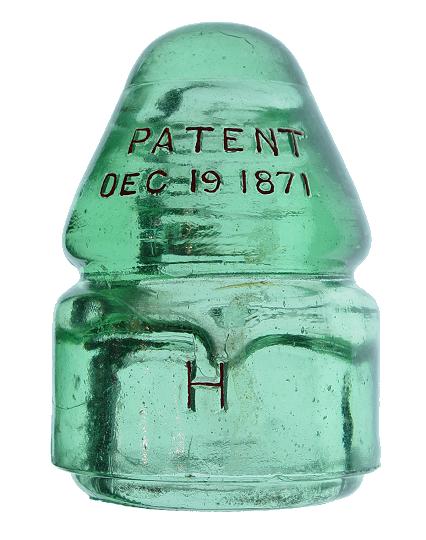
|
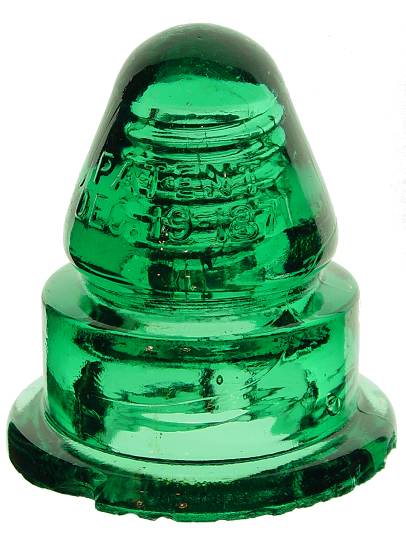 |
|
Big "H" variant (left) & Chambers "Companion" (right) |
Anomalies
One-Liner: A variant of the sixth generation contains a one-line embossing of
the parent date: "PAT. DEC. 19. 1871". A number of insulator designs
manufactured by the Hemingray Glass Company are known to carry this style of
embossing. The one-line embossing appears to have been a short-lived aberration
of the more common two-line embossing style. It is unknown whether or not the
change to the one-line embossing was a company decision or an act of the mold
shop. For whatever the reason, the one-liners are unusual, though should not be
considered rare.
Chambers "Companion": Josephus C. Chambers of Newport, Kentucky
received a patent for "Improvement in Lightning Rods" on May 29, 1877.
The text of the patent described the primary insulator, known to collectors as
the CD 317 "Candlestick". It was installed along the ridgeline of a
roof to support the horizontal run of the lightning rod cable. Illustrations of
the Chambers set-up shows a unique style of insulator attached to a tripod used
to support the vertical points installed at each end of the horizontal run. This
insulator is known to collectors as the "Companion". Above the tie
wire groove, the "Companion" is identical to a No.2 Telegraph
Insulator. The crown front is embossed "PATENT / DEC. 19. 1871. There is no
embossing on the reverse side.
Photographs for this article were taken by
Glenn Drummond, Bill Meier,
Kevin
Jacobson, and Howard Banks
Production & Colors of Insulators
The production of insulators was accomplished by pressing each individual
insulator prior to the introduction of automatic presses. The group of men and
boys who operated a particular insulator press was known as a "shop".
Each shop consisted of approximately seven individuals: a presser,
gathering-boy, turning-out boy, carrying-over boys, and carrying-in boys. It is
estimated that a well coordinated shop could turn out approximately 2,500
insulators per day using two molds.
The insulator presses were situated around a "day tank" which
contained four or more pots to supply the shops. Each pot held enough molten
glass at the beginning of the work day to supply one shop. The pot would be
recharged at the end of the day and fired for approximately 24 hours to melt the
new batch. The next day the shop would draw from a second pot. The batch
consisted of the basic raw ingredients plus cullet (scrap glass). Ordinarily the
batch would contain as much as 50 percent cullet, which gave rise to the variety
and inconsistency of colors found in No.2 Telegraph Insulators.
The amount of cullet added to the batch also had a significant impact on the
time required for the melt. It is possible that the batch could have been melted
and ready for working within twelve hours if it contained approximately 75 to 80
percent cullet. Consequently, rush contracts would be in a variety of color,
some rather unusual, and now considered especially desirable.
The No.2 Telegraph Insulators used along the line extending westward from
Denver to Leadville, Colorado were most likely to have been manufactured under
these circumstances. There were no color standards for glass insulators in the
1800's. Therefore, no effort was made to separate the cullet by color if it was to be mixed into an insulator batch. Some unusual colored No.2 Telegraph
Insulators may be found as a consequence. Colors include light blue, light
purple, and olive green. These colors are considered rare; however there exists
a sufficient number to suggest they came from one or more batch melts during a
run of insulators. The production of insulators was no doubt repetitious and
boring labor that gave rise to a moderate amount of horseplay, especially among the children in the shop. Also note that the
workers were permitted beer breaks during the day, mid-morning, lunch, and mid-afternoon. One of a kinds... such as cobalt blue and "black" glass
insulators...may have resulted from a gathering-boy taking a gob from one of
the pots in the main furnace.
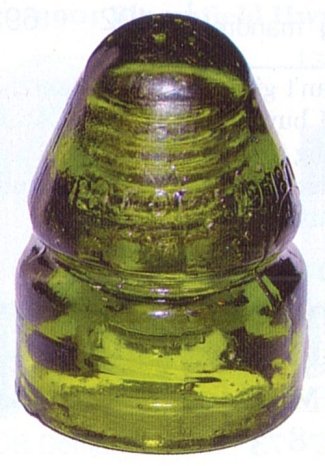
Colorful variant with patent embossing in a single line.
For more information about this article, and for reference notes, contact:
Glenn Drummond
(334) 257-3100
pat.eighteenseventyone@verizon.com
| 